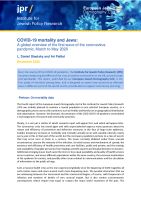COVID-19 mortality and Jews: A global overview of the first wave of the coronavirus pandemic, March to May 2020
Author(s)
Publication Date
December 2020
Publication Place
Publisher
Abstract
This study, the first to assess mortality among Jews around the world during the COVID-19 crisis, draws on data from a wide variety of sources to understand the extent to which Jews were affected by coronavirus in different parts of the world during the first wave of the pandemic, March to May 2020.
The first section describes the methods of quantification of COVID-19 mortality, and explains why measuring it using the excess mortality method is the most effective way to understand how Jewish communities have been affected. The second section presents data on Jewish mortality during the first wave of the COVID-19 epidemic, drawing particularly on data provided to JPR by Jewish burial societies in communities all over the world. It does so in a comparative perspective, setting the data on Jews alongside the data on non-Jews, to explore both the extent to which Jews have been affected by the COVID-19 epidemic, and how the Jewish experience with COVID-19 compares to the experience of non-Jewish populations.
The immediate impression is that there is not a single ‘Jewish pattern’ that is observable everywhere, and, with respect to the presence of excess mortality, Jewish communities, by and large, followed the populations surrounding them.
The report cautions against speculation about why Jews were disproportionately affected in some places, but rule out two candidate explanations: that Jewish populations with particularly elderly age profiles were hardest hit, or that Jews have been badly affected due to any underlying health issue common among them. They consider the possibility that Jewish lifestyle effects (e.g. above average size families, convening in large groups for Jewish rituals and holidays), may have been an important factor in certain instances, noting that these are unambiguous risk factors in the context of communicable diseases. Whilst they suggest that the spread of the virus among Jews “may have been enhanced by intense social contact,” they argue that without accurate quantification, this explanation for elevated mortality in certain places remains unproven.
The report also includes a strongly worded preface from Hebrew University Professor Sergio DellaPergola, the Chair of the JPR European Jewish Demography Unit, and the world’s leading expert in Jewish demography. In it, he stresses the importance of systematically testing representative samples of the population at the national and local levels, and, in Jewish community contexts, of routinely gathering Jewish population vital statistics. He states: “If there is one lesson for Jewish community research that emerges out of this crisis it is that the routine gathering of vital statistics – the monitoring of deaths, as well as births, marriages, divorces, conversions, immigrants and emigrants – is one of the fundamental responsibilities community bodies must take.”
The first section describes the methods of quantification of COVID-19 mortality, and explains why measuring it using the excess mortality method is the most effective way to understand how Jewish communities have been affected. The second section presents data on Jewish mortality during the first wave of the COVID-19 epidemic, drawing particularly on data provided to JPR by Jewish burial societies in communities all over the world. It does so in a comparative perspective, setting the data on Jews alongside the data on non-Jews, to explore both the extent to which Jews have been affected by the COVID-19 epidemic, and how the Jewish experience with COVID-19 compares to the experience of non-Jewish populations.
The immediate impression is that there is not a single ‘Jewish pattern’ that is observable everywhere, and, with respect to the presence of excess mortality, Jewish communities, by and large, followed the populations surrounding them.
The report cautions against speculation about why Jews were disproportionately affected in some places, but rule out two candidate explanations: that Jewish populations with particularly elderly age profiles were hardest hit, or that Jews have been badly affected due to any underlying health issue common among them. They consider the possibility that Jewish lifestyle effects (e.g. above average size families, convening in large groups for Jewish rituals and holidays), may have been an important factor in certain instances, noting that these are unambiguous risk factors in the context of communicable diseases. Whilst they suggest that the spread of the virus among Jews “may have been enhanced by intense social contact,” they argue that without accurate quantification, this explanation for elevated mortality in certain places remains unproven.
The report also includes a strongly worded preface from Hebrew University Professor Sergio DellaPergola, the Chair of the JPR European Jewish Demography Unit, and the world’s leading expert in Jewish demography. In it, he stresses the importance of systematically testing representative samples of the population at the national and local levels, and, in Jewish community contexts, of routinely gathering Jewish population vital statistics. He states: “If there is one lesson for Jewish community research that emerges out of this crisis it is that the routine gathering of vital statistics – the monitoring of deaths, as well as births, marriages, divorces, conversions, immigrants and emigrants – is one of the fundamental responsibilities community bodies must take.”
Topics
Genre
Geographic Coverage
Austria Canada Belgium Germany France France: Paris Belgium: Antwerp Italy Switzerland United Kingdom United Kingdom: London United Kingdom: Manchester United States of America Israel Europe Hungary Hungary: Budapest Sweden Australia Global
Original Language
Link
Download can be found on page, COVID-19 mortality and Jews: A global overview of the first wave of the coronavirus pandemic, March to May 2020
Bibliographic Information
COVID-19 mortality and Jews: A global overview of the first wave of the coronavirus pandemic, March to May 2020. . December 2020: https://archive.jpr.org.uk/object-1431




